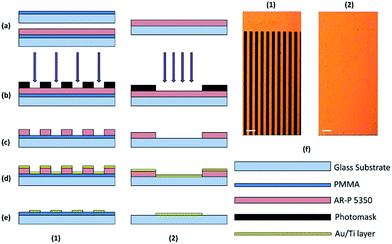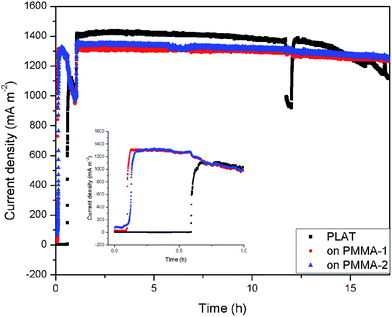A gold microarray electrode on a poly(methylmethacrylate) substrate to improve the performance of microbial fuel cells by modifying biofilm formation†
Shan Chena,
Xiangyu Chenab,
Shuangyue Houa,
Penghui Xionga,
Ying Xionga,
Feng Zhangc,
Hanqing Yuc,
Gang Liua and
Yangchao Tian*a
aNational Synchrotron Radiation Laboratory, University of Science and Technology of China, Hefei, Anhui 230029, People's Republic of China. E-mail: ychtian@ustc.edu.cn
bDepartment of Precision Machinery & Precision Instrumentation, University of Science and Technology of China, Hefei, Anhui 230029, People's Republic of China
cDepartment of Chemistry, University of Science & Technology of China, Hefei, Anhui 230029, People's Republic of China
First published on 22nd November 2016
Abstract
Previous studies have shown that poly(methylmethacrylate) (PMMA) performed better than other polymers and glass in the cell proliferation experiments. However, little attention has been paid to this advantage of PMMA in the study of microbial fuel cells (MFCs). Herein, a gold line microarray electrode deposited on a biocompatible PMMA substrate was designed as an anode to investigate the bacterial attachment and compare with the same gold line microarray electrode on glass and a rectangular plat gold electrode of same surface area. After Shewanella oneidensis MR-1 was injected under anaerobic culture conditions, MFCs using three types of electrodes accomplished similar stable highest current density (approximately 1400 mA m−2), based on their same surface area of gold. However, the one on PMMA showed a superior property in the start-up time, which only needs several minutes. With the continuous operation in eight cycles by periods of time, it always kept the advantage of short start-up time, having a better performance than that of the other two types of electrodes. This means that PMMA was a kind of suitable material for S. oneidensis MR-1 to form an effective biofilm and improve the performance of MFCs. It could be preliminarily explained by the extended Derjaguin–Landau–Verwey–Overbeek (DLVO) theory.
1 Introduction
Microbial fuel cells (MFCs), as a bioelectrochemical system using electrochemically active bacteria which act as a catalyst, can be successfully applied to harvest energy from the wastewater treatment processes.1 Forming a suitable biofilm structure is crucial for maximum power density and sustainable current generation of MFCs, and various methods have been developed to improve the biofilm attachment.2 Shewanella oneidensis MR-1 is an important model electrochemically active bacteria for bioremediation studies because of its diverse electron transfer mechanism,3 including direct transfer through cytochromes and indirect transfer via redox mediators or conductive nanowires. However, the development of a biofilm is conflicting to S. oneidensis MR-1's ability to transfer an electron to an electrode. Although a dense biofilm may be favorable for a direct electron transfer route, it would significantly decrease the indirect electron transfer because of its negative impacts on the mediators across the biofilm.4 Thus, it is necessary to design a suitable electrode structure that could form an effective biofilm to balance the two electron transfer routes, improving the performance of MFCs.Gold, as the most common electrode material used in the microscale MFCs, has the advantages of being biocompatible, highly conductive, and compatible with the conventional microfabrication modalities.5 Taking an advantage of the micromachining techniques to manufacture the gold line array electrodes, prior studies have reported that a gold electrode on this scale can increase the substrate affinity and current density of the electricity-producing G. sulfurreducens biofilms by allowing more biomass per unit surface area of the gold line array electrodes.6 For S. oneidensis MR-1, a previous investigation demonstrated that it was difficult to form productive biofilms on the gold electrodes.7 However, introducing gold line array electrodes would be a feasible choice to overcome this difficulty.
In fact, for gold line array electrodes, the biocompatible substrate used as a supporting layer for the gold electrode was an often overlooked influence factor to improve the performance of MFCs. Polymeric materials, such as poly(methylmethacrylate) (PMMA), poly(dimethylsiloxane) (PDMS), and polystyrene (PS), were usually used as the supporting layers in the microscale MFCs because of their ease of fabrication,8 which were also widely used as supports for cell culturing in medical implants and as scaffolds for tissue regeneration.9 For example, to control cell adhesion on PMMA, researchers have attempted to selectively allow an enhanced cell attachment by modifying the surface10 or forming nanopillars on the PMMA surface.11 Comelles et al. compared the abovementioned three polymeric materials to understand the effect of surface energy and surface roughness on the cell behavior when in contact with the polymeric materials.9 The results showed that PMMA was an excellent choice for the fabrication of lab-on-chip and biosensors because of its outstanding performance in the cell proliferation experiments, better than that of the other two polymers and glass, that makes it an appropriate material for changing the surface properties of gold electrodes to promote the formation of an effective biofilm.
It was suggested that through an appropriate design and fabrication, a gold electrode could be used to build a suitable surface environment for S. oneidensis MR-1 to promote the electron transfer rate by combining the two electron transfer routes. Thus, combining the characteristic of PMMA and gold to the bacterial attachment, special electrode surface may become applicable for improving the performance of MFCs. Based on this, we designed a gold line microarray electrode deposited on a biocompatible PMMA substrate, compared with the same gold line microarray electrode on glass and a rectangular plat gold electrode exposing an equal surface area of gold. The output of current density was observed and analyzed in this study, and the surface properties of different electrodes were preliminarily explained by the extended Derjaguin–Landau–Verwey–Overbeek (DLVO) theory.
2 Materials and methods
2.1 Design concept and microfabrication of gold electrode
Considering the size of S. oneidensis MR-1 at approximately 2–3 μm in length and 0.4–0.7 μm in diameter,12 the gold electrode must be very thin (similar to a planar electrode). Once S. oneidensis MR-1 was attached on a PMMA substrate near the edge of the gold line microarray electrode, it was supposed that the bacteria could be a convenient contact to the surface of the gold electrode in a very short time because of their same height. Based on this consideration, herein, 100 nm thick gold was sputter deposited on PMMA (about 1 μm by spin-coating on glass) and glass to ensure a small height difference between the PMMA substrate and gold electrode. Two types of electrodes were designed: one was a gold array microelectrode of 160 gold lines, each 50 μm wide and 5 cm long, spaced 50 μm apart, for which the geometric surface area (accounting for the entire exposed top beside the lead-out area of the electrode) was 4.4865 cm2, whereas the other one was a 5.6 cm long and 0.8 cm wide rectangular gold electrode, which had a surface area (4.48 cm2) similar to that of the gold line microarray electrode.The schematic of the two electrodes exposing equal gold surface areas along with the microfabrication procedures is illustrated in Fig. 1. The glass substrate was washed with detergent, rinsed with deionized (DI) water and acetone respectively, and then dried on a heated platen at 160 °C for 20 min. The only difference between the fabrication of the rectangular gold electrode and gold array microelectrode was that a layer of 1 μm thick PMMA film was spin-coated on the glass substrate in case of gold array microelectrode. After this, the rest of the procedure was similar. A 1.7 μm thick positive photoresist (AR-P 5350, Allresist GmbH, Germany) was spin-coated on the substrate; in addition, a layer of 1 μm thick PMMA film was spin-coated on the glass substrate at first, prepared for the line array electrode (Fig. 1(a)). After soft-bake, the glass substrate with a positive photoresist was exposed using a photomask (Fig. 1(b)). Subsequently, the exposed positive photoresist was developed in a 0.6% sodium hydroxide solution for 40 s (Fig. 1(c)). Then, a thin layer of titanium and 100 nm thick gold was sputter deposited on the substrate (Fig. 1(d)). After lift-off for several hours, the remaining positive photoresist was removed (Fig. 1(e)). Finally, a gold array microelectrode and a rectangular gold electrode were fabricated (Fig. 1(f)). Thus, three types of gold electrode were designed: (1) gold line microarray electrode on PMMA (MEA-P); (2) gold line microarray electrode on glass (MEA-G); and (3) rectangular gold plat electrode (G-PLAT).
2.2 Bacterial strain and culture media
S. oneidensis MR-1 strain is one of the most common electricigens to study the electron transfer between a bacteria and an electrode surface.3,13 In this experiment, it was aerobically grown in 250 ml of Luria–Bertani (LB) medium (25 g l−1) at 30 °C for 12 h. Subsequently, the strain was washed with 10 mM sterile 4(2-hydroxyethyl) piperazine-1-ethanesulfonic acid (HEPES) buffer (pH = 7.5), and finally resuspended in a 50 ml of a vitamin-free mineral salts medium (MSM) as previously reported.14 The concentration of the S. oneidensis MR-1 suspension liquid was evaluated by measuring the optical density at 600 nm (OD600 = 0.1 after 100 multiple dilution). All the experiments were carried out at 25 °C and the reaction solutions were added to 10 mM HEPES buffer to adjust the pH except when specified otherwise.2.3 Microbial fuel cells design and operation
For assuring the consistent experimental conditions, three types of electrodes were put in an anodic chamber (100 ml) and connected with the same cathode in a cathodic chamber (100 ml), which was also a rectangular gold electrode like the one in the anodic chamber. The electrode surfaces were all perpendicular to the plane of the proton exchange membrane (PEM). Therefore, different results from the experiments could only be attributed to the surface properties of the anode. The resuspended solution (50 ml) was injected into this two-chamber MFC with a 50 mM ferricyanide catholyte solution in the cathodic chamber. Then, 250 ml of the anaerobic medium with 50 mM lactate was slowly injected into the anodic chamber to replace the metabolites of S. oneidensis MR-1 (Fig. S1†). For every closed circuit of three type anode electrodes, the external resistor of MFCs, connecting the anode and cathode, had a resistance value of 1000 Ω. A data acquisition system (NI USB-9207) was employed to determine the output current in turn during the running period. Current density was normalized by the surface area of the gold anode (4.48 cm2).2.4 Electrochemical measurements and SEM observation
Cyclic voltammograms (CVs) for the three types of gold electrodes were obtained using an electrochemical workstation (CHI 800, Chenhua Instrument Ltd., Shanghai) in a solution of 100 mM KCl and 1 mM K3Fe(CN)6/K4Fe(CN)6 at a scan rate of 50 mV s−1 with a Ag/AgCl reference electrode and a Pt counter electrode. The biofilm formed on the gold anode in the MFCs after 18 h operation was observed using a scanning electron microscope (SEM, raith, Co., Germany).3 Results
3.1 Electrochemical characteristics of the gold electrodes
The three types of gold anodes were characterized by cyclic voltammetry (Fig. 2). Typical reversible peak-type volt–ampere curves were observed for these anodes, suggesting that these anodes possessed reliable and high electrochemical catalytic activities. However, the gold microarray electrodes, no matter on glass or on PMMA, showed higher and similar peak currents than that of the rectangular gold electrode. Based on their same gold surface area, it was suggested that the gold line microarray electrodes had a better electrochemical performance than that of the rectangular gold electrode, which is independent of the substrate material.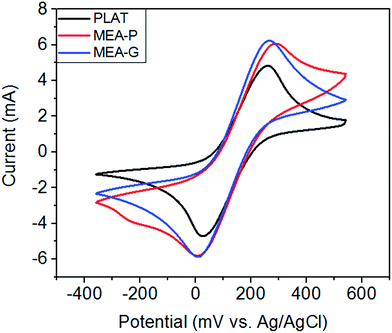 | ||
| Fig. 2 Cyclic voltammograms of different electrodes in a solution with 100 mM KCl and 1 mM K3Fe(CN)6/K4Fe(CN)6 at a scan rate of 50 mV s−1. | ||
3.2 Electricity generation in the MFC with the gold electrodes
After the resuspended solution (50 ml) was injected into the two-chamber MFC, the output current of the three types of electrodes was determined in turn. Because of the absence of lactate as an electron donor, currents stabilized around zero at the beginning stage, which could eliminate the possibility of capacitor discharge of the gold electrode. Once 250 ml of the anaerobic medium with 50 mM lactate was slowly injected into the anodic chamber, current in the MFC with the MEA-P anode quickly increased, followed by the MFC with the MEA-G anode, and the last one was the MFC with the G-PLAT anode. The maximum currents in the MFCs with the MEA-P anode and MEA-G anode were at the same level of 1400 mA m−2, whereas it was 1200 mA m−2 in the MFC with G-PLAT (Fig. 3).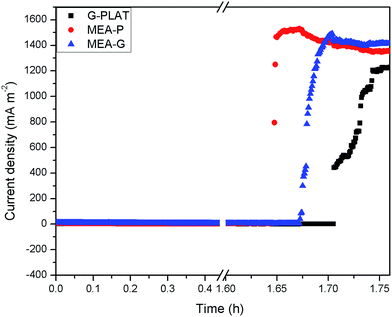 | ||
| Fig. 3 Current generation in the MFCs with different anodes. 250 ml anaerobic medium with 50 mM lactate was slowly injected into the anodic chamber. | ||
It could be recognized that a similar highest current density of three electrodes was obtained because of the similar gold surface area.
3.3 The stability and reproducibility in the MFC with the gold electrodes on PMMA
The time taken for the MFCs to reach the highest and stable current density in this study could be regarded as the start-up time. As shown in Fig. 3, the rising time of the current density was very short after lactate was injected as an electron donor; thus, an another parallel experiment was performed for testing the start-up time and verifying the stability and reproducibility in the MFC with the gold electrodes on PMMA.In this experiment, the resuspended solution (50 ml) was injected into the two-chamber MFC with 50 mM lactate. As shown in Fig. 4, the two MFCs with a MEA-P anode showed a very similar performance and the current density increased in about 10 minutes, which was distinguished better than the other similar configurations. Moreover, the required start-up time was generally long (typically from several days to a month).15,16 After 1 hour, with the consumption of lactate, the current density decreases to 1000 mA m−2. Moreover, when 250 ml anaerobic medium with 50 mM lactate was slowly injected into the anodic chamber, the current density increased to 1400 mA m−2 in about 10 minutes, which is similar to that of the previous experiment. Finally, the system was reliably run for more than 15 h, which demonstrates that the gold electrodes on PMMA had the advantages of stability and reproducibility under continuous operating conditions.
3.4 The advantages of MEA-P anode in the recovery current density of MFCs under continuous operating conditions
The operation system of the MFCs was artificially broken into eight cycles by taking away one-third of the liquid from the anodic chamber every time to investigate the recovery ability of the current density by the MEA-P anode in the MFCs. The performance of the MFCs for eight cycles with different electrodes is shown in Fig. 5.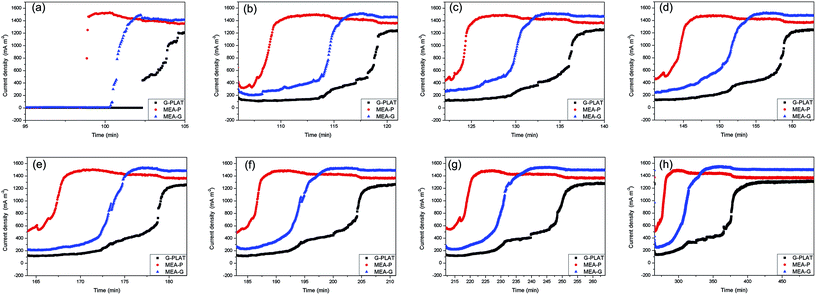 | ||
| Fig. 5 Eight cycles of current generation in the MFCs with different anodes under steady injection conditions. | ||
This caused a dramatic current-dropping, which reduced one-third of the lactate content. Thus, at the beginning of every cycle, the current density of the three electrodes rapidly dropped to below 600 mA m−2; the current density of MFC with G-GLAT dropped fastest, followed by the MFC with MEA-G and MFC with MEA-P, respectively. Finally, the highest and stable current density of the three electrodes could all reach about 1400 mA m−2, and the curve of three electrodes exhibited a similar increasing trend with no consideration of the increasing time for reaching the highest current density. In every cycle (except the first one (Fig. 5(a)) and the last one (Fig. 5(h))), the current density for MFC with the MEA-P anode began to increase in 10 minutes as compared to that of the one in the parallel experiment. This was followed by the current density of the MFC with the MEA-G anode that reached the highest stable current density in about 15 minutes. The last one was the MFC with the G-PLAT anode, which needed 20 minutes or more to achieve the highest current density. It suggested that the MEA-P anode retained the advantage of a quick recovery of the current density much better than the other two types of electrodes.
3.5 SEM observations of S. oneidensis MR-1 biofilm on MEA-P and MEA-G anodes
It was confirmed that S. oneidensis MR-1 cells were attached to the surface of the G-PLAT, MEA-P, and MEA-G anodes (Fig. 6) after 18 h. A dense S. oneidensis MR-1 cell layer was formed on the MEA-G surface, whereas clusters of S. oneidensis MR-1 cells were observed on the MEA-P surface. No matter whether on the gold surface (Fig. 6(b) and (e)) or on the substrate surface (Fig. 6(c) and (f)), the formation of the S. oneidensis MR-1 biofilm maintained the same modality. It suggested that the surface of gold and substrate had consistency in the formation of the biofilm under dozens or tens of microns of the gold microarray electrode. However, S. oneidensis MR-1 cells on the surface of G-PLAT, no matter whether on the gold surface (Fig. 6(g)) or the glass surface (Fig. 6(i)), were comparatively sporadic. The status of the S. oneidensis MR-1 biofilm on the surface of the plat gold electrode was considerably different from that on the surface of the gold line microarray electrode.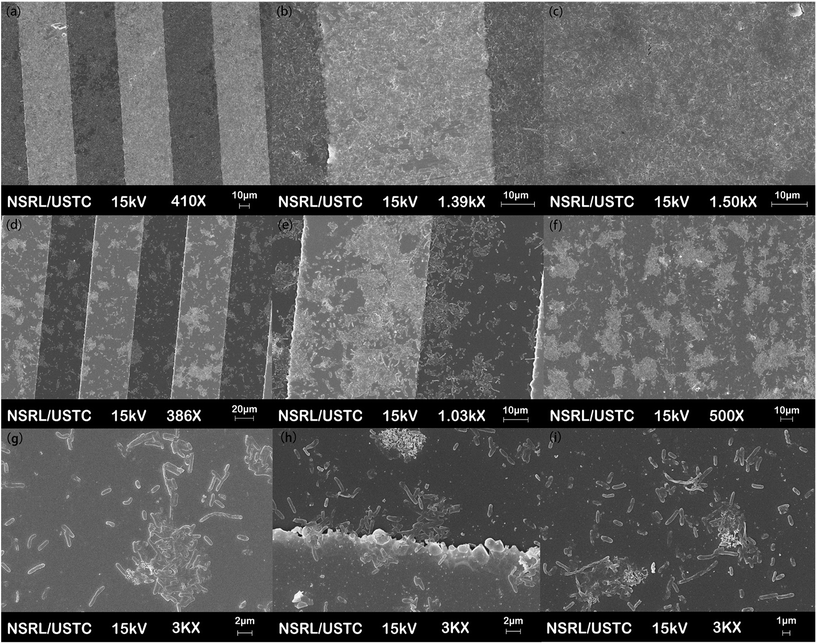 | ||
| Fig. 6 SEM images of S. oneidensis MR-1 cells attached on the surface of MEA-G (a–c), MEA-P (d–f) and G-PLAT (g–i). | ||
4 Discussion
In this study, gold line microarray electrodes deposited on the biocompatible PMMA substrate and glass were designed as the gold line microarray electrodes and were compared with a rectangular plat gold electrode of same surface area with a very thin gold electrode (∼100 nm) similar to a planar electrode and different from those in other reports. Recent advances have shown that a gold electrode in this scale could increase the substrate affinity and current density of the electricity-producing G. sulfurreducens biofilms by allowing more biomass per unit surface area from the gold line array electrodes.6 In this report, the thickness of the gold electrode was 700–750 μm, considerably larger than the size of G. sulfurreducens. However, in our study, the gold electrode could be regarded as a planar electrode, with the biomass per unit surface area of gold line array electrodes being almost the same, resulting in similar highest current density of these three electrodes. However, the gold microarray electrode on the poly(methylmethacrylate) substrate (MEA-P) exhibited advantages, such as a rapid start-up time and good stability and reproducibility, better than that of the other two materials. It could offer a new insight for the configuration of MFCs.As an interface of bacterial adsorption, the surface characteristics of the substrate obviously played an important role in the bacterial attachment process. However, it has been found that zeta potentials and contact angles cannot be simply used to determine the ability of the bacteria to adhere onto the polymer surfaces,17,18 which also may depend on the physicochemical properties of bacteria cells, their growth phase and the availability of nutrients. Therefore, the adhesion of the bacteria to the solid surfaces was a complicated process. Currently, a two-phase process was proposed that involved an initial reversible physicochemical adsorption of the cells followed by an irreversible molecular and cellular phase, and some references had indicated that the optimum value of the surface free energy for which the bacterial adhesion was not less than 25 mJ m−2.19,20 The PMMA substrate, with a surface free energy of about 40 mJ m−2, was very suitable for biofilm formation. As the gold electrode could be approximately considered as similar to a planar anode, once the PMMA substrate between the gold array microelectrode space was attached to S. oneidensis MR-1, the edge of the gold electrode was contacted with the bacteria at the same time, which could be investigated by the SEM images of the electrode edge (Fig. 6(b), (e) and (h)). Accordingly, with the promotion effect of PMMA on the biofilm formation under the appropriate surrounding conditions, it was supposed that the start-up time was greatly shortened because of the rapid adhesion of the bacteria to the surface.
To date, the extended Derjaguin–Landau–Verwey–Overbeek (DLVO) theory is the most comprehensive theory to analyse the free energy of interactions between the bacteria and the substrates.21,22 This phenomenon in this study could also provide a preliminary theoretical explanation combined with the SEM images of the MR-1 cells attached on the surface. By a series of calculation and measurements based on the theoretical analysis of the interactions between bacteria and surface topography in a previous research study,21 bacteria-PMMA and bacteria-GLASS interaction curves were produced and are shown in Fig. S2.† Based on the extended DLVO theory, while the energies of the primary maximum were too high to overcome, bacteria would stay at the place where the secondary minimum appeared, which could only form loose and unstable biofilms. Therefore, after the process of sample preparation for SEM, the loose and unstable biofilms only left clusters of cells on the MEA-P surface, as shown in Fig. 5(d–f). This special structure might not benefit from a stable biofilm but could afford enough space for mediators across the biofilm. As a result, the MFCs with the MEA-P electrode could achieve the same level of current density as that of the MFCs with the MEA-G electrode and retain the advantage of an ultra-rapid start-up, thus optimizing the overall performance of the MFCs. Moreover, riboflavin, as a soluble redox mediator able to enhance the rate of electron transfer to the electrodes produced by the attached cells,23 was also detected by the fluorescence detection method in this study. With the same microarray electrode structure, a loose and unstable biofilm was formed on PMMA, which showed a rapid start-up of MFCs, and retained the advantage of quick recovery of current density. Therefore, the MEA-P electrode was a suitable special structure electrode that could form an effective S. oneidensis MR-1 biofilm to balance the two electron transfer routes. However, because of the much lower primary maximum, which was too easy for S. oneidensis MR-1 to overcome, it could attach to the glass surface, which had difficulty in detaching. A dense biofilm was observed in the SEM images of S. oneidensis MR-1 cells on the MEA-G electrode, where the bacteria-GLASS interaction was analysed. As a conclusion, the extended DLVO theory, as an effective tool to predict the behavior of bacterial attaching on the substrates, was helpful to optimize the surface properties of the anode material.
At present, more and more researchers are focusing on miniaturizing the microbial fuel cells to develop new applications and comprehend the microbial/anode interface.5,24 Due to the requirements of manufacturing materials, gold was the most commonly used material for electrodes in micro-MFCs. However, the limitation of size brought about big challenges such as current output and an unacceptable biofouling occurring over time,25 which made microscale MFCs to employ low initial concentrations of bacteria to avert any possible blockages. In addition, the highest current density was still too low. If a microelectrode was used in the mesoscale MFCs, these two problems could have been solved. In this study, based on the use of a microelectrode and two-chamber mesoscale MFC, a biocompatible polymer as the substrate could dramatically shorten the start-up time (Table 1), and the maximum current density was maintained for a relatively long time under non-turnover conditions. At the same time, it was proved that using a microelectrode in a mesoscale MFCs had great advantages and potential in the optimization of the start-up process. It may offer some references for the researchers engaged in the design of microscale and mesoscale MFCs.
As is known, electrode materials play an important role in the performance of MFCs,29 no matter if they are microscale or mesoscale MFCs. The property of the electrode surface would influence the forming process of the bacterial biofilms, thereby affecting the electron transfer efficiency of bacteria to an electrode. Combining interface effects of a biocompatible substrate material to bacteria, the gold microarray electrode could show outstanding performance in MFCs. In this study, even with the width of microelectrode being much larger than that of the bacteria, it displayed the advantages of rapid start-up. Thus, with the development of microfabrication technology, once the size of the microelectrode was reduced to the magnitude of a single-bacterium, the interface effect of the biocompatible substrate material may be more significant to bacterial attachment. It was reported that single-bacterium analyses will be one of the most attractive techniques for comprehending the key electrochemical and biochemical processes at the bacterial/electrode interface,24 and the proposed method in this study would be a simple and an effective research method to promote the investigation of adhesion behavior between bacteria and the surface of an electrode.
5 Conclusions
The unique characters of the gold microarray electrode based on a PMMA substrate included its very short start-up time and its ability to quickly recover the current density in the two-chamber MFCs, which is much better than that of the other similar MFCs with conventional electrodes. Based on the analysis of the extended DLVO theory and measurements on the basis of the CVs and SEM images, it could be demonstrated that the PMMA substrate could influence the formation of the biofilm on the gold line microarray electrode under dozens or tens of microns' scale, thereby improving the performance of the MFCs. A new way to optimize the anode architecture of MFCs was found, no matter if it was microscale or mesoscale MFCs.References
- B. E. Logan, B. Hamelers, R. A. Rozendal, U. Schrorder, J. Keller, S. Freguia, P. Aelterman, W. Verstraete and K. Rabaey, Environ. Sci. Technol., 2006, 40, 5181–5192 CrossRef CAS PubMed.
- B. E. Logan, B. Hamelers, R. Rozendal, U. Schröder, J. Keller, S. Freguia, P. Aelterman, W. Verstraete and K. Rabaey, Environ. Sci. Technol., 2006, 40, 5181–5192 CrossRef CAS PubMed.
- D. Baron, E. LaBelle, D. Coursolle, J. A. Gralnick and D. R. Bond, J. Biol. Chem., 2009, 284, 28865–28873 CrossRef CAS PubMed.
- F. Zhang, S. J. Yuan, W. W. Li, J. J. Chen, C. C. Ko and H. Q. Yu, Electrochim. Acta, 2015, 152, 1–5 CrossRef CAS.
- S. Choi, Biosens. Bioelectron., 2015, 69, 8–25 CrossRef CAS PubMed.
- Y. Liu, H. Kim, R. Franklin and D. R. Bond, Environ. Sci. Technol., 2010, 3, 1782–1788 CAS.
- A. L. Kane, D. R. Bond and J. A. Gralnick, ACS Synth. Biol., 2013, 2, 93–101 CrossRef CAS PubMed.
- S. Choi, Biosens. Bioelectron., 2015, 69, 8–25 CrossRef CAS PubMed.
- J. Comelles, M. Estévez, E. Martínez and J. Samitier, Nanomedicine: Nanotechnology, Biology and Medicine, 2010, 6, 44–51 CrossRef CAS PubMed.
- S. Patel, R. G. Thakar, J. Wong, S. D. McLeod and S. Li, Biomaterials, 2006, 27, 2890–2897 CrossRef CAS PubMed.
- J. Ahn, S. J. Son and J. Min, J. Biotechnol., 2013, 164, 543–548 CrossRef CAS PubMed.
- H. H. Hau and J. A. Gralnick, Annu. Rev. Microbiol., 2007, 61, 237–258 CrossRef CAS PubMed.
- J. Babauta, R. Renslow, Z. Lewandowski and H. Beyenal, Biofouling, 2012, 28, 789–812 CrossRef CAS PubMed.
- B. E. Logan, C. Murano, K. Scott, N. D. Gray and I. M. Head, Water Res., 2005, 39, 942–952 CrossRef CAS PubMed.
- A. Fraiwan, S. Mukherjee, S. Sundermier, H. S. Lee and S. Choi, Biosens. Bioelectron., 2013, 49, 410–414 CrossRef CAS PubMed.
- X. Wang, Y. J. Feng, N. Q. Ren, H. M. Wang, H. Lee, N. Li and Q. L. Zhao, Electrochim. Acta, 2009, 54, 1109–1114 CrossRef CAS.
- B. Gottenbos, H. C. Van der Mei, H. J. Busscher, D. W. Grijpma and J. Feijen, J. Mater. Sci.: Mater. Med., 1999, 10, 853–855 CrossRef CAS PubMed.
- G. Harkes, J. Feijen and J. Dankert, Biomaterials, 1991, 12, 853–860 CrossRef CAS PubMed.
- D. Hadjiev, D. Dimitrov, M. Martinov and O. Sire, Enzyme Microb. Technol., 2007, 40, 840–848 CrossRef CAS.
- M. Hocevar, M. Jenko, M. Godec and D. Drobne, Mater. Tehnol., 2014, 48, 609–617 Search PubMed.
- X. Ge, Y. Leng, X. Lu, F. Z. Ren, K. F. Wang, Y. H. Ding and M. Yang, J. Biomed. Mater. Res., Part A, 2015, 103, 384–396 CrossRef PubMed.
- K. B. Fu, H. Lin, S. Chen and X. F. Wang, Miner. Metall. Process., 2015, 32, 121–128 Search PubMed.
- E. Marsili, D. B. Baron, I. D. Shikhare, D. Coursolle, J. A. Gralnick and D. R. Bond, Proc. Natl. Acad. Sci. U. S. A., 2008, 105, 3968–3973 CrossRef CAS PubMed.
- F. Qian and D. E. Morse, Trends Biotechnol., 2011, 29, 62–69 CrossRef CAS PubMed.
- A. ElMekawy, H. M. Hegab, X. Dominguez-Benetton and D. Pant, Bioresour. Technol., 2013, 142, 672–682 CrossRef CAS PubMed.
- Y. F. Han, C. L. Yu and H. Liu, Biosens. Bioelectron., 2010, 25, 2156–2160 CrossRef CAS PubMed.
- S. Choi, H. S. Lee, Y. Yang, P. Parameswaran, C. I. Torres, B. E. Rittmann and J. Chae, Lab Chip, 2011, 11, 1110–1117 RSC.
- F. Qian, Z. He, M. P. Thelen and Y. Li, Bioresour. Technol., 2011, 102, 5836–5840 CrossRef CAS PubMed.
- M. H. Zhou, M. L. Chi, J. M. Luo, H. H. He and T. Jin, J. Power Sources, 2011, 196, 4427–4435 CrossRef CAS.
Footnote |
| † Electronic supplementary information (ESI) available. See DOI: 10.1039/c6ra22152a |
| This journal is © The Royal Society of Chemistry 2016 |

